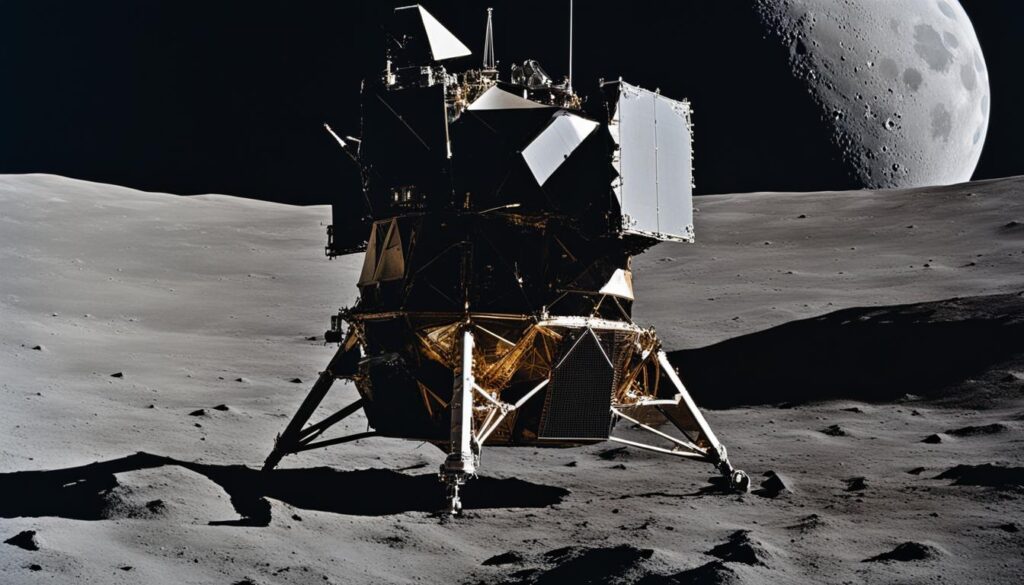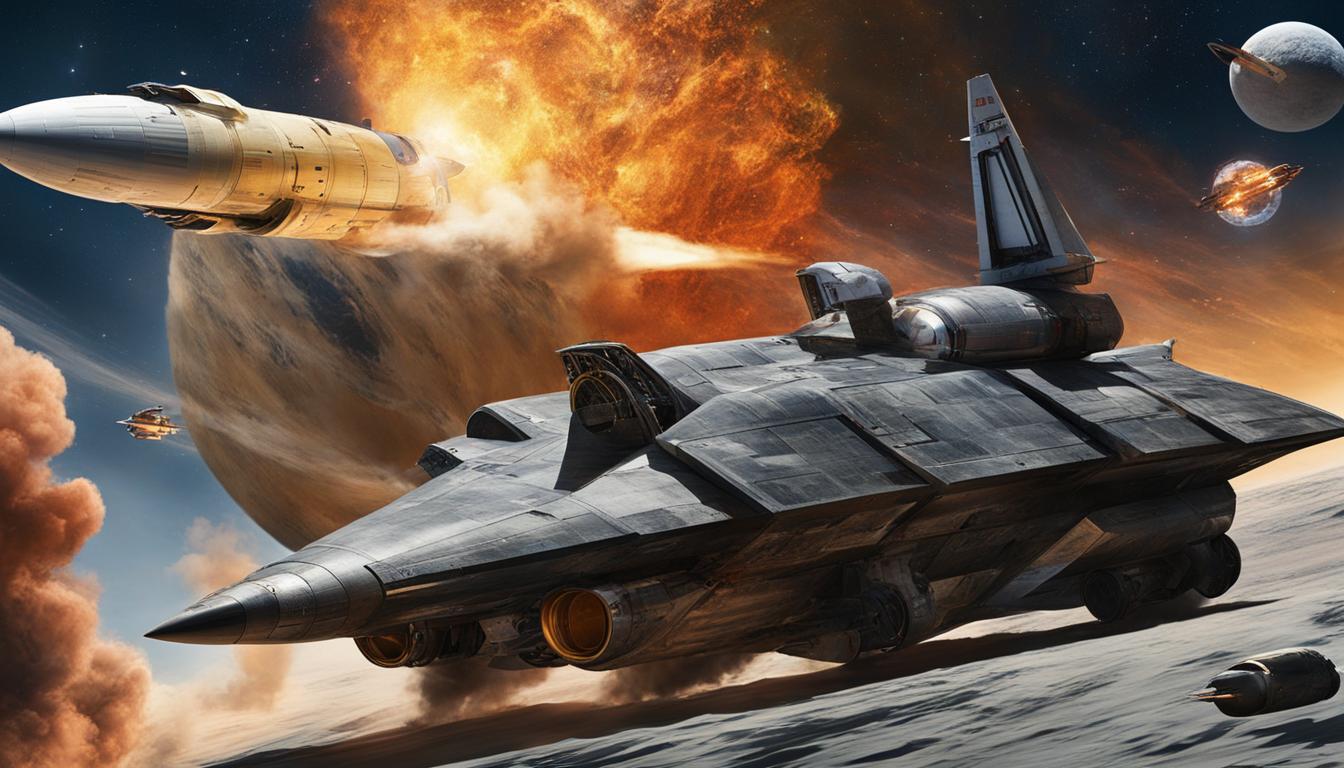Welcome to our in-depth exploration of the Space Race, a riveting chapter in history that pitted the Soviet Union against the United States during the tumultuous Cold War era. This fierce competition was driven by a multitude of motives, intertwining politics, technological advancement, and the quest for global influence.
The Space Race was a direct result of the intense rivalry and power struggle between the two superpowers. It served as a battleground for showcasing political ideologies and determining which nation would emerge as the dominant force. Both the Soviet Union and the United States recognized the tremendous significance of space exploration and invested substantial resources to develop their space technologies.
Through the Space Race, these superpowers sought to demonstrate their technological prowess and establish themselves as leaders on a global stage. Each milestone achieved in space exploration represented a leap forward in scientific innovation and military capabilities, enhancing their status as Cold War rivals.
Join us as we delve into the captivating history of the Space Race, examining the major milestones, setbacks, and ultimately, the crowning achievement that defined this era of human endeavor.
Contents
- 1 The Beginning of the Space Race
- 2 Major Milestones in the Space Race
- 3 Setbacks and Tragedies
- 4 Apollo Missions and the Moon Landing
- 5 Conclusion
- 6 FAQ
- 6.1 Why did the superpowers compete to develop space exploration technology?
- 6.2 What were the major milestones in the Space Race?
- 6.3 What setbacks and tragedies occurred during the Space Race?
- 6.4 What were the Apollo missions and the significance of the moon landing?
- 6.5 What were the implications of the Space Race during the Cold War?
- 7 Source Links
Key Takeaways:
- The Space Race was driven by the intense rivalry and competition between the Soviet Union and the United States during the Cold War.
- Political motivations and the quest for global influence played a significant role in fueling the race for space technology development.
- The Space Race showcased the technological advancements and capabilities of the superpowers, as they vied for superiority in space exploration.
- Major milestones, setbacks, and tragedies defined the course of the Space Race, shaping the trajectory of international space exploration.
- The United States’ successful moon landing in 1969 marked the end of the Space Race and solidified its position as the victor.
The Beginning of the Space Race
The Space Race, a significant chapter in history, commenced with the groundbreaking launch of Sputnik 1, the world’s first artificial satellite. On October 4, 1957, the Soviet Union successfully sent Sputnik 1 into orbit, which had a profound impact on the international community. This remarkable feat intensified the competition between the superpowers and set the stage for a race into the unknown.
In their pursuit of supremacy, the Soviet Union continued to push the boundaries of space exploration. They elevated the stakes by sending Sputnik 2 into orbit, with a living creature on board – a courageous dog named Laika. The mission of Sputnik 2 further advanced the Soviet Union’s dominance in the realm of space technology.
Responding to the Soviet Union’s achievements, the United States launched Explorer 1, its first satellite, in January 1958. This successful endeavor showcased the American commitment to staying at the forefront of space exploration and marked the beginning of the United States’ active participation in the Space Race.
The opening of NASA in July 1958 further solidified the United States’ dedication to space exploration. With the establishment of this prestigious agency, the United States unraveled its ambitious plans to conquer the cosmos, captivating the nation and the world with its aspirations.
The Soviet Union continued to assert its dominance in the space race with the launch of Luna 1 in January 1959. This historic mission saw Luna 1 become the first spacecraft to fly near the Moon, paving the way for future lunar missions and highlighting the Soviet Union’s technological prowess.
| Date | Event |
|---|---|
| October 4, 1957 | Soviet Union launches Sputnik 1, the first artificial satellite |
| November 3, 1957 | Soviet Union launches Sputnik 2, carrying the first living creature, Laika, into space |
| January 31, 1958 | United States successfully launches Explorer 1, its first satellite |
| July 29, 1958 | Opening of NASA, signaling the American commitment to space exploration |
| January 2, 1959 | Soviet Union launches Luna 1, the first mission to fly over the surface of the Moon |
Major Milestones in the Space Race
The Space Race between the Soviet Union and the United States witnessed several significant milestones that marked the advancements and achievements in space exploration. Let’s delve into some of these major milestones.
Soviet Union’s Vostok 1
In April 1961, the Soviet Union accomplished a groundbreaking feat with the launch of Vostok 1. This historic mission carried Yuri Gagarin, who became the first person to orbit the Earth. The successful journey of Vostok 1 demonstrated the Soviet Union’s technological prowess and established their dominance in the early stages of the Space Race.
United States’ Mercury Redstone 3
Shortly after the Soviet Union’s achievement, the United States made its mark in space exploration. In May 1961, Alan Shepard became the first American to travel to space aboard the Mercury Redstone 3 spacecraft. Although Shepard’s flight was suborbital, it laid the foundation for future manned space missions.
Kennedy’s Promise and Vostok 2
Amidst the intense space competition, President John F. Kennedy made a bold promise in May 1961. He declared that the United States would put a man on the moon before the end of the 1970s. This ambitious goal set the stage for further advancements in the American space program.
The Soviet Union didn’t slow down either. In August 1961, they launched Vostok 2, which carried Gherman Titov, the second person to orbit the Earth. This mission showcased their continuous progress in manned space exploration.
United States’ Mercury Atlas 6
In February 1962, the United States achieved another major milestone with the launch of Mercury Atlas 6. This mission, also known as the Friendship 7, carried astronaut John Glenn, who became the first American to orbit the Earth. Glenn’s successful orbit demonstrated the United States’ increasing capabilities in manned space travel.
| Vostok 1 | Mercury Redstone 3 | Kennedy’s Promise | Vostok 2 | Mercury Atlas 6 |
|---|---|---|---|---|
| April 1961 | May 1961 | May 1961 | August 1961 | February 1962 |
| Yuri Gagarin became first human to orbit the Earth. | Alan Shepard became first American in space on a suborbital flight. | President Kennedy pledged to land a man on the moon by the end of the decade. | Gherman Titov became second person to orbit the Earth. | John Glenn became the first American to orbit the Earth. |
The launch and success of missions like Vostok 1, Mercury Redstone 3, and Mercury Atlas 6 propelled the Space Race further, setting the stage for more significant achievements in the years to come.

Setbacks and Tragedies
The Space Race, despite its achievements, was not without its setbacks and tragedies. These unfortunate events marked significant turning points in the race to conquer space. Two notable incidents, the death of Sergey Korolyov and the Apollo 1 disaster, cast a shadow over the progress made by both the Soviet Union and the United States.
Sergey Korolyov dies of a heart attack
In January 1966, the Soviet Union suffered a devastating loss with the untimely death of Sergey Korolyov, one of the country’s key rocket engineers. Korolyov’s visionary leadership and technical expertise had propelled the Soviet space program to great heights. His passing left a void that was difficult for the Soviet Union to fill. The loss of Korolyov’s guidance and expertise posed significant challenges for the Soviet space program, slowing down their progress in the race for space exploration.
Apollo 1 Tragedy
The United States also faced a tragic setback on January 27, 1967, when a fire broke out during a launch simulation in the command module of the Apollo 1 spacecraft. The fire swiftly engulfed the capsule, resulting in the deaths of three brave astronauts: Gus Grissom, Edward White, and Roger Chaffee. This devastating event highlighted the risks and dangers associated with space exploration and served as a stark reminder of the sacrifices made in pursuit of the lunar landing goal. The Apollo 1 tragedy prompted a reevaluation of safety protocols and procedures and brought about important changes that ensured the safety of future missions.
These setbacks and tragedies served as somber reminders of the risks inherent to space exploration. While they were undoubtedly heartbreaking, they also propelled both nations to make critical improvements and approach space exploration with renewed determination and vigilance.
| Date | Event | Significance |
|---|---|---|
| January 1966 | Death of Sergey Korolyov | Loss of a key figure in the Soviet space program, posed challenges for future advancements. |
| January 27, 1967 | Apollo 1 Fire | Tragic incident resulting in the deaths of Gus Grissom, Edward White, and Roger Chaffee. Led to improvements in safety protocols. |
Apollo Missions and the Moon Landing
The Apollo missions played a pivotal role in the intense competition of the Space Race. One of the major milestones occurred in December 1968 with the launch of Apollo 8, becoming the first crewed mission to orbit the moon. This remarkable achievement marked a significant turning point in the race for lunar dominance.
However, it was the Apollo 11 mission that truly captured the world’s attention and solidified the United States’ triumph in the Space Race. On July 20, 1969, astronauts Neil Armstrong, Buzz Aldrin, and Michael Collins embarked on the historic journey to the moon. After a breathtaking descent, Armstrong became the first person to set foot on the moon’s surface, famously declaring, “That’s one small step for man, one giant leap for mankind.”
This momentous occasion fulfilled the promise made by President John F. Kennedy in his 1961 speech, cementing the United States’ position as the winner of the Space Race and igniting a sense of pride and accomplishment across the nation.

The Apollo 11 mission not only showcased the incredible technological advancements achieved by NASA, but it also symbolized the triumphs of human ingenuity, determination, and exploration. The successful moon landing represented a monumental leap forward in our understanding of the universe and our capabilities as a species.
“That’s one small step for man, one giant leap for mankind.” – Neil Armstrong
The Apollo missions, particularly Apollo 8 and Apollo 11, will forever be remembered as significant milestones in human history, demonstrating our unwavering desire to explore the unknown and push the boundaries of what is possible.
Conclusion
The Space Race between the Soviet Union and the United States during the Cold War era was driven by political and ideological motivations. The competition to advance space exploration technology was a reflection of the larger rivalry between the superpowers. The achievements made by both nations in their space programs had far-reaching implications for global influence and military capabilities.
The United States’ successful moon landing in 1969 with the Apollo 11 mission marked the culmination of the Space Race and a significant victory for the nation. This achievement not only demonstrated the technological prowess and superiority of the United States but also restored a sense of national pride and confidence. The moon landing served as a symbol of the country’s triumph over its Cold War adversary and solidified its position as the winner of the Space Race.
While the tensions of the Cold War continued to persist, the Space Race showcased the immense capabilities of both nations in space exploration. It was not just a competition for scientific and technological advancement, but also a battle for ideological dominance and global supremacy. The Space Race had a profound impact on the course of history and significantly shaped the geopolitical landscape of the time.
In conclusion, the Space Race between the Soviet Union and the United States came to a close with the United States emerging as the victor. The race not only propelled humanity’s exploration of space but also exemplified the intense rivalry and geopolitical implications of the Cold War. It remains a testament to the incredible achievements made by both nations in their pursuit of technological excellence.
For more information on the space race and its historical significance, visit our Space Race History page.
FAQ
Why did the superpowers compete to develop space exploration technology?
The superpowers, the Soviet Union and the United States, competed in space exploration technology as part of the larger rivalry and competition of the Cold War era. They recognized the political importance of space exploration and saw it as a way to demonstrate superiority and global influence.
What were the major milestones in the Space Race?
The major milestones in the Space Race include the Soviet Union’s launch of Sputnik 1 and Sputnik 2, the United States’ launch of Explorer 1 and the opening of NASA, and the Soviet Union’s launch of Luna 1. The Space Race also saw the Soviet Union’s Vostok 1 mission with the first human in space and the United States’ Mercury Atlas 6 mission with John Glenn orbiting the Earth.
What setbacks and tragedies occurred during the Space Race?
The Space Race faced setbacks and tragedies, including the death of Soviet rocket engineer Sergey Korolyov and the Apollo 1 fire that resulted in the deaths of three American astronauts: Gus Grissom, Edward White, and Roger Chaffee.
What were the Apollo missions and the significance of the moon landing?
The Apollo missions were a series of crewed missions by the United States that aimed to land humans on the moon. The climax of the Space Race came with the Apollo 11 mission, in which Neil Armstrong, Buzz Aldrin, and Michael Collins successfully landed on the moon’s surface. This historic event fulfilled President Kennedy’s promise and solidified the United States’ position as the winner of the Space Race.
What were the implications of the Space Race during the Cold War?
The Space Race had significant implications for global influence and military capabilities during the Cold War. It showcased the technological prowess and superiority of the United States, leading to a sense of pride and confidence in the nation.




